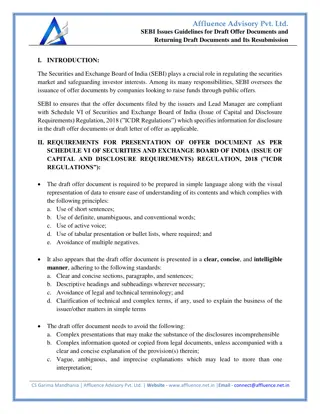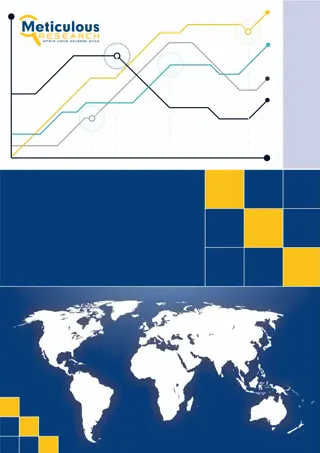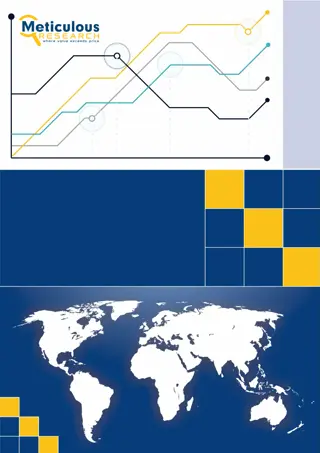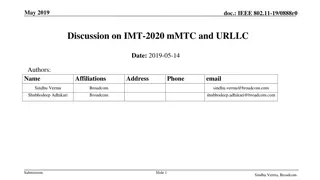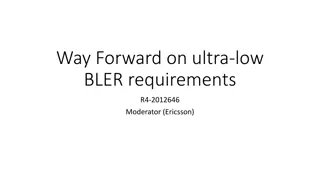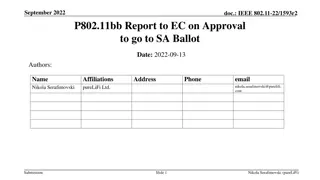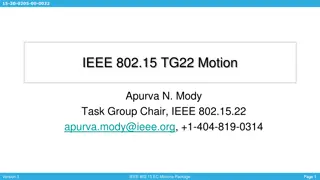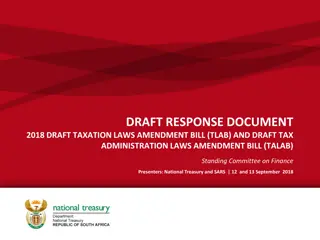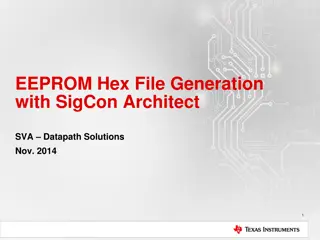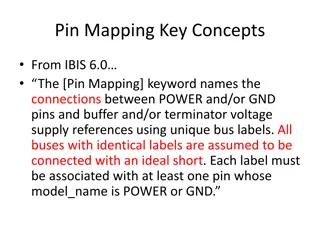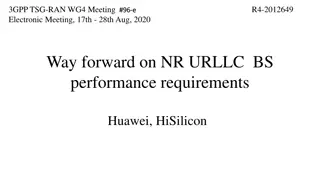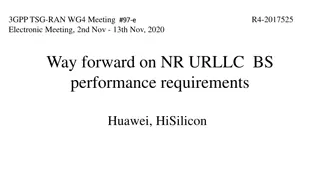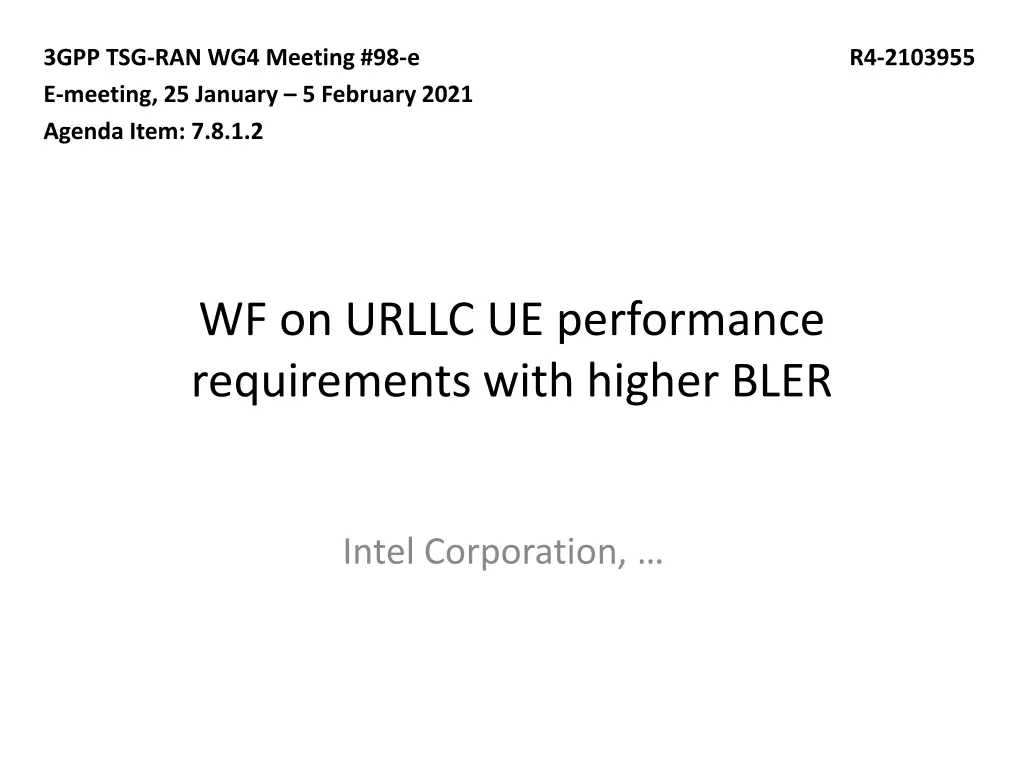
High Reliability Requirements for URLLC UE Performance in 3GPP Meeting
Explore the detailed specifications for high reliability in URLLC UE performance requirements discussed at the 3GPP TSG-RAN Working Group meeting. Covering parameters from previous meetings, this agenda dives into configurations, scheduling, MCS, pre-emption indication, and more for FR1 and FR2 scenarios.
Download Presentation

Please find below an Image/Link to download the presentation.
The content on the website is provided AS IS for your information and personal use only. It may not be sold, licensed, or shared on other websites without obtaining consent from the author. If you encounter any issues during the download, it is possible that the publisher has removed the file from their server.
You are allowed to download the files provided on this website for personal or commercial use, subject to the condition that they are used lawfully. All files are the property of their respective owners.
The content on the website is provided AS IS for your information and personal use only. It may not be sold, licensed, or shared on other websites without obtaining consent from the author.
E N D
Presentation Transcript
3GPP TSG-RAN WG4 Meeting #98-e E-meeting, 25 January 5 February 2021 Agenda Item: 7.8.1.2 R4-2103955 WF on URLLC UE performance requirements with higher BLER Intel Corporation,
FR1 High reliability (1) Background (Agreed parameters from #94e, #94e-Bis, #95e, #96e and #97e) SCS/CBW: FDD: 15 kHz/10 MHz TDD: 30 kHz/40 MHz TDD pattern: 7D1S2U, S=6D: 4G: 4U for 30 kHz SCS. PDSCH configuration: Mapping type A, symbol length 12, starting symbol 2. Aggregation level: 2 for FDD and TDD Max number of HARQ transmissions: 4 FDD: No scheduling in slots 0 and 1 (or 19) within 20ms. TDD: No scheduling in D slots i, where mod(i, 10) = 0, and S slots HARQ process number: 4 for FDD and TDD MCS 19 Antenna configuration: 2x2 and 2x4, ULA low Propagation condition: TDLA30-10 Target BLER: 1% (BLER is calculated after all transmission ) BLER calculation method BLER = NpacketFail/NpacketTx, where NpacketFail is the number of packets with CRC fail after all transmissions (initial and retransmissions), NpacketTx is the total number of packets transmitted during the test. Target Confidence level: 99% 2
FR1 High reliability (2) The number of slots between PDSCH and corresponding HARQ-ACK information for FDD The number of slots between final repetition PDSCH and corresponding HARQ-ACK information: 2 The number of slots between PDSCH and corresponding HARQ-ACK information for TDD 6 if mod(i,10) = 2 5 if mod(i,10) = 4 3 if mod(i,10) = 6 3
FR2 High reliability (1) Background (Agreed parameters from #97e) SCS/BW: 120 kHz / 100 MHz TDD pattern: DDSU, S=11:3:0 PDSCH configuration Frequency domain resource allocation: Full bandwidth Mapping Type A, Start symbol 1, Length 13 PDSCH aggregation factor: n2 Scheduling: No scheduling in D slot i, where mod(i,160) = 0 and mod(i, 160) = 1, and S slots DM-RS configuration: Type 1, Single-symbol DM-RS, 1 additional DM-RS PT-RS configuration: Frequency density 2, Time density 1, RE offset 2 Overhead for TBS determination: 6 HARQ process: 2 Maximum number of HARQ re-transmission: 4 Channel model: TDLA30-75 Antenna configuration: 2x2, ULA low Test metric: 1% BLER 4
FR2 High reliability (2) MCS: MCS16 from Table 3 5
Pre-emption indication (1) Background (Agreed parameters from #94e, 94e-bis, 95e and 96e) No URLLC PI performance requirements Time frequency set: 14x1 Number of symbols to be pre-empted: 2 Starting symbol to be pre-empted: 3 Pre-emption scheduling: Fixed scheduling Test applicability for eMBB UE PI requirements: optional with UE capability signalling Antenna Configuration: 2x2 and 2x4, ULA low The assumption of UE behaviours for buffer flushing and decoding If UE cannot decode the PDCSH correctly, UE feeds back NACK to gNB. Then UE flushes the buffer and waits for the next re-transmission for LLR combing to decode the PDSCH. URLLC interference modelling SNR: Same as for eMBB transmission Structure: Some random data 6
Pre-emption indication (2) Background (Agreed parameters from #94e, 94e-bis, 95e and 96e) Use the following parameters for eMBB PDSCH configuration Parameter Duplex mode Active DL BWP index Mapping type k0 Starting symbol (S) Length (L) PDSCH aggregation factor PRB bundling type PRB bundling size Resource allocation type RBG size VRB-to-PRB mapping type Value FDD, TDD 1 Type A 0 2 12 1 Static 2 Type 0 Config2 Non-interleaved PDSCH configuration VRB-to-PRB mapping interl bundle size N/A DMRS Type Number of additional DMRS Maximum number of OFDM symbols for DL front loaded DMRS Type 1 1 PDSCH DMRS configuration 1 FDD: 4, TDD: 8 Number of HARQ Processes Maximum HARQ transmission 4 The number of slots between PDSCH and corresponding HARQ-ACK information and TDD pattern FDD: 2 TDD: FR1.30-1 FDD: 10/15, TDD: 40/30 Full bandwidth Rank 1 TDLA30-10 CBW/SCS RB allocation MIMO layer Propagation condition 7
Pre-emption indication (3) Pre-emption probability 10% within 1 radio frame Pre-emption pattern for TDD [0 1 0 0 0 0 0 0 0 0, 0 0 1 0 0 0 0 0 0 0, 0 0 0 1 0 0 0 0 0 0, 0 0 0 0 1 0 0 0 0 0] eMBB MCS MCS 16 in Table 1 Test metric 70% of max T-put 8



